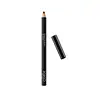What's inside
What's inside
 Key Ingredients
Key Ingredients

 Benefits
Benefits

No benefits
 Concerns
Concerns

 Ingredients Side-by-side
Ingredients Side-by-side

Lauryl Dimethicone
Skin ConditioningCetearyl Ethylhexanoate
EmollientSynthetic Wax
AbrasivePolybutene
Polymethyl Methacrylate
Cera Alba
EmollientC20-24 Alkyl Dimethicone
Skin ConditioningCopernicia Cerifera Wax
Cera Microcristallina
Emulsion StabilisingPolyethylene
AbrasiveTrimethylsiloxysilicate
EmollientLecithin
EmollientWater
Skin ConditioningTocopherol
AntioxidantAscorbyl Palmitate
AntioxidantMica
Cosmetic ColorantDicalcium Phosphate
AbrasiveSynthetic Fluorphlogopite
Citric Acid
BufferingTin Oxide
AbrasiveCI 77891
Cosmetic ColorantCI 15850
Cosmetic ColorantCI 19140
Cosmetic ColorantCI 45410
Cosmetic ColorantCI 73360
Cosmetic ColorantCI 77491
Cosmetic ColorantCI 77492
Cosmetic ColorantCI 77499
Cosmetic ColorantCI 42090
Cosmetic ColorantLauryl Dimethicone, Cetearyl Ethylhexanoate, Synthetic Wax, Polybutene, Polymethyl Methacrylate, Cera Alba, C20-24 Alkyl Dimethicone, Copernicia Cerifera Wax, Cera Microcristallina, Polyethylene, Trimethylsiloxysilicate, Lecithin, Water, Tocopherol, Ascorbyl Palmitate, Mica, Dicalcium Phosphate, Synthetic Fluorphlogopite, Citric Acid, Tin Oxide, CI 77891, CI 15850, CI 19140, CI 45410, CI 73360, CI 77491, CI 77492, CI 77499, CI 42090
Dimethicone
EmollientTrimethylsiloxysilicate
EmollientSynthetic Fluorphlogopite
Silica
AbrasivePolyisobutene
Polyethylene
AbrasiveOzokerite
Emulsion StabilisingAcrylates/Stearyl Acrylate/Dimethicone Methacrylate Copolymer
Disteardimonium Hectorite
StabilisingPentaerythrityl Tetra-Di-T-Butyl Hydroxyhydrocinnamate
AntioxidantPropylene Carbonate
SolventCI 77891
Cosmetic ColorantIron Oxides
CI 15850
Cosmetic ColorantCI 45410
Cosmetic ColorantDimethicone, Trimethylsiloxysilicate, Synthetic Fluorphlogopite, Silica, Polyisobutene, Polyethylene, Ozokerite, Acrylates/Stearyl Acrylate/Dimethicone Methacrylate Copolymer, Disteardimonium Hectorite, Pentaerythrityl Tetra-Di-T-Butyl Hydroxyhydrocinnamate, Propylene Carbonate, CI 77891, Iron Oxides, CI 15850, CI 45410
 Reviews
Reviews

Ingredients Explained
These ingredients are found in both products.
Ingredients higher up in an ingredient list are typically present in a larger amount.
Ci 15850 is the pigment color red. It is an azo dye and created synthetically.
Azo dyes need to be thoroughly purified before use. This allows them to be more stable and longer-lasting.
This ingredient is common in foundations, lipsticks, and blushes. This color is described as brown/orangey red.
It has many secondary names such as Red 6 and Red 7. According to a manufacturer, Red 6 usually contains aluminum.
Learn more about CI 15850CI 45410 is a synthetic red-pigment and dye.
It often goes by both Red 28 or Red 27; manufacturers label both ingredients as CI 45410.
This dye is commonly found in makeup because it imparts a vivid color. Some types of this dye change color based on pH level and interaction with moisture:
Your skin has a natural pH of around 4.5 - 5.5.
According to the FDA, CI 45410 is not permitted for use in eye products.
Red 27 is a flourescein dye and commonly used as a fluorescent tracer in medicine.
Learn more about CI 45410Ci 77891 is a white pigment from Titanium dioxide. It is naturally found in minerals such as rutile and ilmenite.
It's main function is to add a white color to cosmetics. It can also be mixed with other colors to create different shades.
Ci 77891 is commonly found in sunscreens due to its ability to block UV rays.
Learn more about CI 77891Polyethylene is a synthetic ingredient that helps the skin retain moisture. It is a polymer.
It is also typically used within product formulations to help bind solid ingredients together and thicken oil-based ingredients. When added to balms and emulsions, it helps increase the melting point temperature.
Synthetic Fluorphlogopite is the synthethic version of mica. It consists of fluorine, aluminum and silicate.
Synthetic Fluorphlogopite is used to add volume to products.
It is considered non-irritating on the skin.
Learn more about Synthetic FluorphlogopiteThis silicone is an emollient. Emollients create a thin film on the skin to prevent moisture from escaping.
It is not soluble in water and helps increase water-resistance in products.
According to a manufacturer, it can blend seamlessly with silicone oils, such as Cyclopentasiloxane.
Learn more about Trimethylsiloxysilicate